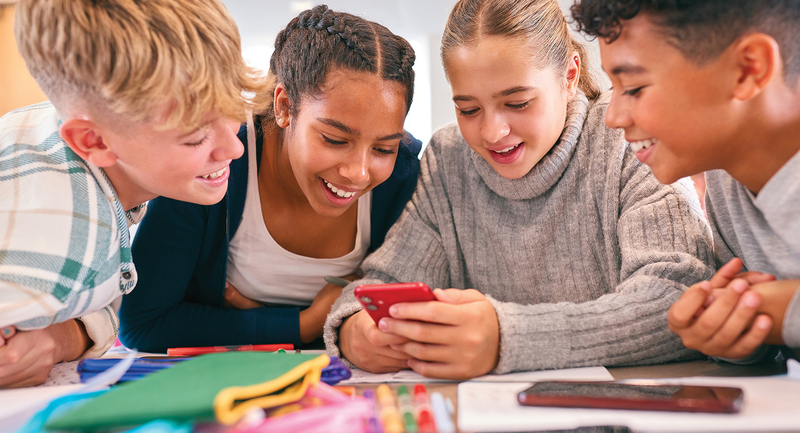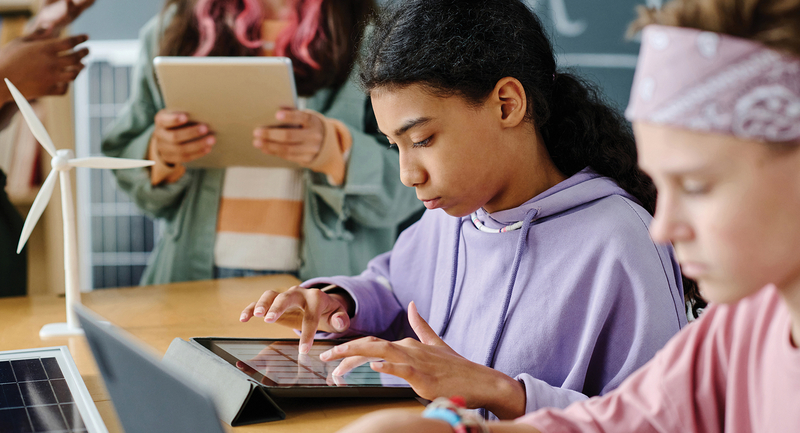Teachers who have taught exclusively offline in a traditional school setting may find the transition to teaching online daunting and foreign. As educators navigate this new reality of school closures, social isolation, and remote learning, it's important to remember that education and learning encompass more than disseminating and collecting assignments. Learning, at its core, is a social endeavor. People learn through their interactions with each other and the world around them. Given the social nature of learning, educators who are moving their classes online must prioritize community building to ensure their students thrive online.
The Community of Inquiry theoretical framework underpins much of the research on online and blended learning and is grounded in collaborative constructivism (Swan, Garrison, & Richardson, 2009). Given the concerns many teachers have about the isolating nature of online courses, I appreciate the focus that the Community of Inquiry places on creating a community of learners who can make meaning while interacting online. This framework provides a structure for teachers to design and facilitate an online course to effectively engage students in active learning. The Community of Inquiry framework is composed of three interconnected presences—social presence, teaching presence, and cognitive presence. The social presence refers to the learners' ability to assert their social and emotional selves, view their classmates as real people, and communicate openly online. The teaching presence encompasses the design, instruction, and facilitation of learning in the course. Finally, the cognitive presence is learners' ability to construct meaning through a process of inquiry, dialogue, and reflection (Garrison, Anderson, & Archer, 2000). Understanding the interplay between these presences can help teachers transitioning their courses online create learning experiences that are engaging, student-centered, and leverage the class' collective intelligence. As teachers move online, a critical first step is to create a safe virtual space that will help students develop their social presence. Traditional teachers shifting classes online mid-year due to school closures may assume that their students know each other and will feel comfortable participating in academic conversations and collaborative tasks online. But I would caution teachers not to assume that the community they have established in-person will automatically translate to the online environment. There are likely students in our classes who have shared the physical classroom all year but who may have never spoken or collaborated on a shared task. The transition to learning online presents an opportunity for teachers to make sure that everyone in the class community knows each other and forms relationships with their peers online that will make their interactions more respectful and rewarding.
The first step in establishing open, honest, and respectful communication in an online community is to clearly define the expectations for behavior in the online environment. Teachers concerned about what students might say or do online should ask their classes to think about and articulate the behaviors they believe will help them to feel comfortable engaging with peers and sharing ideas. Teachers can ask the class to articulate these expectations on a shared digital document.
Asking students to craft the norms and expectations for their online interactions gives them ownership of the space and creates an incentive for them to abide by these guidelines. Teachers can add additional items to the list or ask students to consider specific behaviors to ensure the guidelines address the teacher's concerns about online interactions. Once a clear guide has been established, teachers can pose questions about what consequences are appropriate when the expectations for online communication have been violated. This places the responsibility on the community to think through the appropriate response to missteps, and students are more likely to internalize these expectations and think about what they say and do online.
A staple of any online course is discussion, and a good online discussion can be a great way to build community and communication skills. Icebreaker discussion questions, like the ones in Figure 1, can help students learn about their peers and help them to view their HEAD classmates as real people with feelings, values, and beliefs.
Figure 1. Online Icebreaker Discussion Questions
Icebreaker: If you could have any superpower, which would you choose and why?
If you could have one of the superpowers below, which would you choose and why?
ability to become invisible
ability to read other people's minds
Begin your post by clearly stating the superpower you would like and thoroughly explain your choice.
Once you have posted your response, please read and reply thoughtfully to at least 2 other members of the class. In your reply, ask questions, comment on specific points made, compliment the ideas shared, and build on ideas shared.
Research has established that higher levels of perceived social presence in an online course yield higher levels of interaction, engagement, and satisfaction with that course (Tu & McIsaac, 2002). This suggests that the investment teachers make in building a cohesive online community with a strong social presence will pay dividends. The Teaching Presence: Designing and Facilitating Online Learning Experiences
Teaching online is obviously different from teaching in a physical classroom, yet there are areas of overlap that may help traditional teachers feel more comfortable making the move online. When I work with teachers who are teaching a blended or entirely online course for the first time, I encourage them to treat their Google Classroom or learning-management system (like Schoology or Canvas) as their online classroom—to think of it as a place where students engage and learn, not just a place to just post things. This is the place where students will access information and resources, engage with their teacher and their peers, and submit their work for feedback and evaluation.
Once teachers begin to treat their learning-management system as their virtual classroom, they can begin to think about their roles and responsibilities in this online environment. The Community of Inquiry framework specifically identifies course design, direct instruction, and facilitation of learning as central to the teaching presence in an online course (Swan et al., 2009). Traditional teachers must think differently about the organization and design of their online courses. It is a mistake to think that K–12 students who spend seven hours a day in a traditional classroom can spend that same amount of time in front of a computer at home. That is an unrealistic, and frankly unhealthy, expectation. Students who are isolated at home because of school closures and social distancing mandates are juggling a lot mentally and emotionally. They are negotiating a shared space with their family. They may be sharing devices and limited bandwidth with parents and siblings. They may also be dealing with fear and anxiety about the current health crisis.
It's important to adopt a modular approach to designing distance-learning experiences. Teachers must break up the learning activities into smaller parts and give students time to self-pace through those activities. The beauty of online learning lies in the flexibility it affords learners. I would encourage teachers to plan a week at a time and post all of the videos, articles, podcasts, online discussion questions, and assignments that students will need at the start of the week. When teachers post the week's work, they should clearly identify the learning objectives for the week, due dates for specific tasks, and times when the teacher will be available for "office hours" via video conferencing tools like Google Meet or Zoom. This approach allows learners the luxury of completing tasks at a time and pace that works for them.
The Cognitive Presence: Engaging the Class in Meaning Making
If teachers think about the building blocks of a traditional lesson, they will begin to see how those modular activities (direct instruction, discussion, collaborative group work, and others) can be shifted online using a variety of tools, many of which are probably already embedded into their learning-management system. Figure 2 breaks down some of the basic building blocks that educators use to design offline lessons and describes how teachers can use technology tools to engage students in these activities online.
Figure 2. The Building Blocks of an Online Lesson
Successfully Taking Offline Classes Online - table
Building Block | Objective | Online Tools |
|---|
| Direct Instruction | Transfer information (lecture or mini-lesson) or explain a complex topic. | Use Screencastify or QuickTime to record a screencast. |
| Modeling | Conduct a think-aloud as you navigate a task, apply a strategy, practice a skill, or use an online tool or resource. | Use Screencastify or QuickTime to record a video showing students how to do something or record a screencast to demonstrate how to navigate something online. |
| Discussion | Engage students in academic conversations about a text, video, podcast, topic, or issue. | "Post discussion questions on Google Classroom or use the discussion question feature in your learning management system to engage students in asynchronous text-based discussions. Host a synchronous discussion using a video conferencing tool like Google Meet or Zoom to allow students to engage in a real-time discussion." |
| Research and Exploration | Encourage students to research a topic or issue and crowd- source the information they find. | Give students a topic to research online and ask them to crowdsource what they are learning in a shared space online (an online discussion board, shared online document or slide deck, Padlet Wall, or FlipGrid). |
| Collaborative Tasks | Group students online and allow them to work collabora- tively on shared tasks. | Use a collaborative suite, like Google or Microsoft, to engage groups of students online (shared documents or slide decks). |
| Practice and Review | Connect students with practice and review activities. | "Use online resources, like Quizizz, Kahoot!, Quizlet, KhanAcademy, or NoRedInk, to encourage review and to create retrieval activities. Use digital documents (Google Documents or Microsoft OneNote) to assign review activities or writing assignments." |
| Assessment | Assess student work and use that data to determine what students need moving forward. | "Administer tests and quizzes using online assessment tools. Assign a writing prompt, task, or project designed to assess the students' mastery of content and skills." |
| Reflection and Metacognitive Skill Building | Ask students to think about what they learned, how they learned it, what questions they have about the concepts or skills covered, and what support they need to continue improving. | Use Google Forms, Microsoft Forms, or Socrative to create an end-of-the-week exit ticket to encourage students to develop their metacognitive muscles. Teachers can also ask students to reflect in an online journal or learning log about their progress each week. |
Source: Catlin R. Tucker
As teachers think about how these individual building blocks fit together to form a learning experience that extends over a week or several weeks, it is helpful to consider using the 5Es instructional model—engage, explore, explain, elaborate, and evaluate—as a guide when arranging these building blocks (Bybee, 2015). This model provides teachers with a clear path to designing a learning experience that will develop the cognitive presence in a distance-learning community. It prioritizes inquiry, exploration, collaboration, and communication. Teachers begin by engaging students in a conversation about what they think or wonder, what they already know, or what they would like to find out about a particular topic. Then students explore the topic. Teachers can provide links to articles, videos, and podcasts about a topic, or students can conduct their own research. The "explain" phase of this cycle encourages students to share what they have learned, and the elaborate phase encourages students to make connections between what they are learning and other concepts covered in the course as well as their lives beyond the classroom. It also gives them opportunities to practice, review, and apply what they learned. The learning cycle ends with an evaluation activity to assess what students learned or to ask them to engage in a reflective activity thinking about what they learned to develop their metacognitive muscles.
The beauty of the 5Es instructional model is that it emphasizes the role of the learner in the process of making meaning in a course. Student-Centered Online Learning
Just because learning is moving online does not mean that students should be relegated to the role of passive receivers of information. Instead, I would like to see teachers prioritize student-centered learning by developing online communities and designing lessons that leverage technology tools and instructional models that actively engage students in each part of the learning process.








